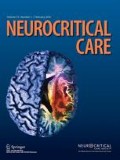And you somehow think that predicting poor outcome HAS ANY FUCKING USE TO SURVIVORS?
Do the damn research that prevents such poor outcomes! I'd fire you all including your mentors and senior researchers! The goal of stroke research is to get survivors recovered, not tell them how poorly they will recover because your stroke medical 'professionals' HAVE DONE NOTHING IN THE PAST 50 YEARS TO GET TO 100% RECOVERY!
Added Value of Frequency of Imaging Markers for Prediction of Outcome After Intracerebral Hemorrhage: A Secondary Analysis of Existing Data
Abstract
Background
Frequency of imaging markers (FIM) has been identified as an independent predictor of hematoma expansion in patients with intracerebral hemorrhage (ICH), but its impact on clinical outcome of ICH is yet to be determined. The aim of the present study was to investigate this association.
Methods
This study was a secondary analysis of our prior research. The data for this study were derived from six retrospective cohorts of ICH from January 2018 to August 2022. All consecutive study participants were examined within 6 h of stroke onset on neuroimaging. FIM was defined as the ratio of the number of imaging markers on noncontrast head tomography (i.e., hypodensities, blend sign, and island sign) to onset-to-neuroimaging time. The primary poor outcome was defined as a modified Rankin Scale score of 3–6 at 3 months.
Results
A total of 1253 patients with ICH were included for final analysis. Among those with available follow-up results, 713 (56.90%) exhibited a poor neurologic outcome at 3 months. In a univariate analysis, FIM was associated with poor prognosis (odds ratio 4.36; 95% confidence interval 3.31–5.74; p < 0.001). After adjustment for age, Glasgow Coma Scale score, systolic blood pressure, hematoma volume, and intraventricular hemorrhage, FIM was still an independent predictor of worse prognosis (odds ratio 3.26; 95% confidence interval 2.37–4.48; p < 0.001). Based on receiver operating characteristic curve analysis, a cutoff value of 0.28 for FIM was associated with 0.69 sensitivity, 0.66 specificity, 0.73 positive predictive value, 0.62 negative predictive value, and 0.71 area under the curve for the diagnosis of poor outcome.
Conclusions
The metric of FIM is associated with 3-month poor outcome after ICH. The novel indicator that helps identify patients who are likely within the 6-h time window at risk for worse outcome would be a valuable addition to the clinical management of ICH.

No comments:
Post a Comment